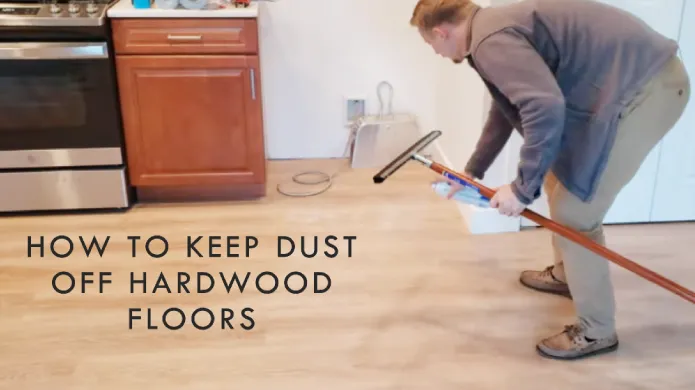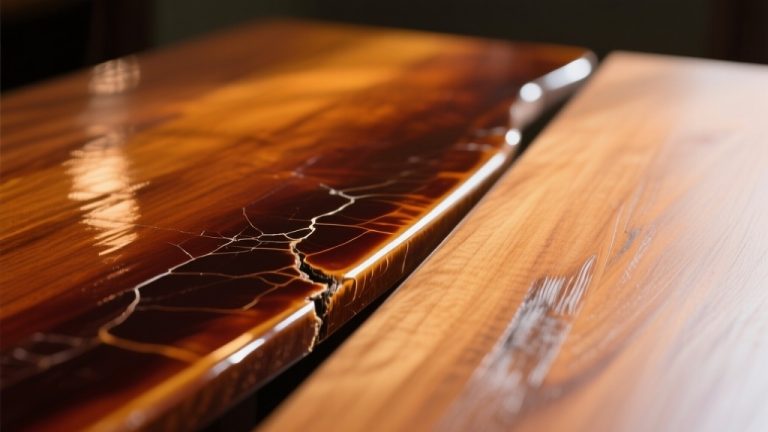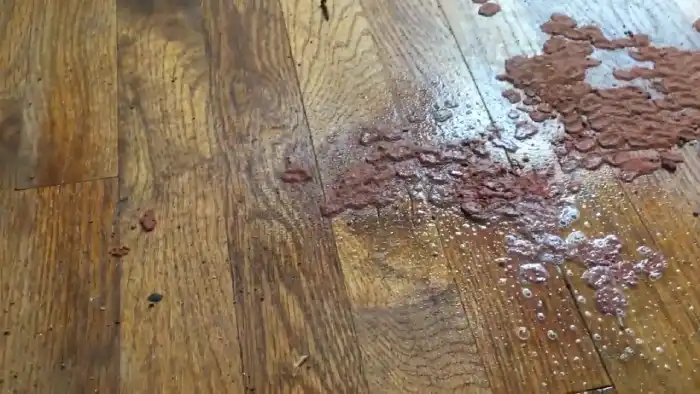How Much to Strip and Refinish Hardwood Floors: 6 Key Factors
Old unfinished hardwood floors can present a myriad of problems for house owners and residents alike. And before you decide on whether to refinish or replace them, it’s essential to consider a few factors, including the costs.
According to the national average, refinishing a hardwood floor can cost around $1,828, with a typical range of $1,098 to $2,599. But, these figures can fluctuate due to various factors such as floor dimensions, hardwood flooring types, local labor costs, and the experience of the refinishing company.
With average costs per square foot ranging from $3 to $8, refinishing is an important process that must be explored thoroughly.
Here, we’ll discuss the factors that affect hardwood floor refinishing costs, the process of refinishing hardwood floors. Also, we talk about when it might be best to avoid refinishing altogether.
What Affects Hardwood Floor Refinishing Costs?

Regarding hardwood floor refinishing costs, there are several key factors to consider. Here are the primary factors that can affect your overall cost:
- Floor dimensions
- Hardwood flooring types
- Local labor costs
- Company experience
- Additional factors
- Moving furniture
- Removing old flooring
- Repairs
- Cleanup
- Geographic location
Let’s take a deeper look into each of these factors.
No 01: Floor Dimensions
To determine the cost of stripping and refinishing your hardwood floors, consider the dimensions of your floor. The size of the area to be refinished is a crucial factor that affects the overall cost.
If you’re refinishing an entire house, you can expect a higher total cost compared to just refinishing a single room. Then again, it’s crucial to note that larger projects often have a lower cost per square foot. This means that while the total cost may be higher, the cost per square foot is generally more affordable for larger areas.
| Room Size (Square Foot) | Cost to Refinish Hardwood |
| 40 | $200 to $350 |
| 100 | $300 to $500 |
| 144 | $450 to $750 |
| 256 | $800 to $1,300 |
| 400 | $1,200 to $2,000 |
| 576 | $1,750 to $2,900 |
| 1,000 | $3,000 to $5,000 |
| 2,000 | $6,000 to $10,000 |
| 3,000 | $9,000 to $15,000 |
No 02: Hardwood Flooring Types
If you’re considering different types of hardwood flooring, you’ll find that each type can have a slight variation in the cost of refinishing. The cost per square foot may depend on the type of wood used for the flooring, such as oak, cherry, bamboo, maple, and more.
Oak is a popular choice for hardwood flooring due to its durability and classic look. It is known for its natural grain pattern and can be stained in various shades to complement any decor.
In contrast, cherry hardwood flooring offers a rich and luxurious appearance. Its reddish-brown color deepens over time, creating a warm and inviting atmosphere.
Bamboo flooring is an eco-friendly option that is highly resistant to moisture and scratches. It has a unique and contemporary look that adds a touch of modernity to any space.
Maple hardwood flooring is known for its light color and smooth grain, making it a popular choice for contemporary and minimalist designs.
| Hardwood Flooring Types | Refinishing Cost Per Square Foot |
| Bamboo | $2 to $6 |
| Mahogany | $6 to $8 |
| Oak | $3 to $5 |
| Cherry | $3 to $5 |
| Parquet | $3 to $5 |
| Maple | $6 to $8 |
| Pine | $4 to $7 |
| Engineered Hardwood | $3 to $5 |
No 03: Local Labor Costs
For a more accurate estimate, you should research the labor costs for refinishing your hardwood floors in your local area. Labor costs can vary greatly depending on where you are located.
Metropolitan areas or regions with high labor demand tend to have higher labor costs compared to rural areas. This is because there is often more competition for skilled workers in areas with higher labor demand, which drives up the cost.
Additionally, the cost of living in metropolitan areas is generally higher, which can also contribute to higher labor costs.
No 04: Company Experience
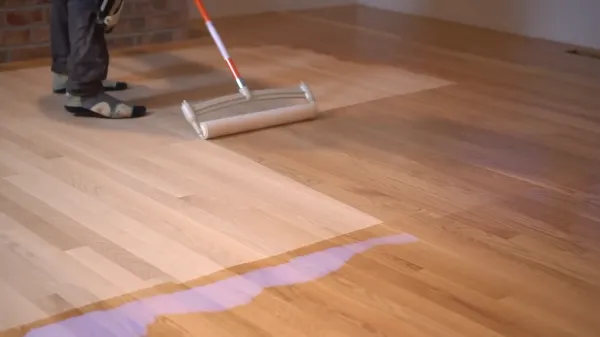
You should consider the experience of the flooring company when determining the cost. Established and experienced companies may charge higher rates, but their work is likely to be of higher quality.
When a company has been in the business for a significant amount of time, they have had the opportunity to refine their skills and techniques. They have likely encountered a wide range of flooring issues and have developed effective solutions.
This experience allows them to handle any challenges that may arise during the stripping and refinishing process, ensuring a smooth and successful outcome.
Additionally, experienced companies often have a strong reputation within the industry, which can provide you with peace of mind knowing that you are working with a trusted professional.
No 05: Additional Factors
As it pertains to stripping and refinishing hardwood floors, several additional factors must be considered.
Moving Furniture
To properly strip and refinish your hardwood floors, you must consider the cost of moving furniture. While some contractors may charge extra for this service, it is not typically included in the estimate.
Therefore, discuss this aspect with your contractor to determine any additional costs involved.
Removing Old Flooring
If the old flooring is hidden beneath other materials, such as carpet or vinyl, removing it may incur additional costs. This process involves carefully removing the existing flooring to expose the hardwood underneath. Depending on the type and condition of the old flooring, it may require specialized tools and techniques.
Repairs
Before refinishing, you may need to consider repairs to address any extensive damage to your hardwood floor. Repair work is essential to ensure a smooth and durable finish.
Damaged areas such as scratches, gouges, or water stains must be carefully repaired to restore the floor’s integrity. This may involve sanding down the damaged areas, filling them with wood filler, and sanding again for a seamless finish.
Professional assistance may be required to handle complex repairs effectively.
Cleanup
Cleanup after refinishing can be a time-consuming and dusty process. Not all refinishing estimates include cleanup services, so you may need to hire a cleaning service separately.
The process involves removing the dust and debris accumulated during refinishing. This may include sweeping, vacuuming, and mopping the floors and wiping down surfaces to remove any remaining dust particles.
Geographic Location
When refinishing hardwood floors, remember that the cost can vary based on location. Different areas have different price ranges due to variations in the local economy and cost of living.
In regions with a higher cost of living, such as major cities or affluent suburbs, you can expect to pay more for the stripping and refinishing process. On the other hand, the prices may be more affordable in areas with a lower cost of living.
Some states or regions may have higher labor costs or stricter regulations, which can also impact the overall cost. Therefore, it’s essential to research and compare prices in your location to get an accurate estimate for stripping and refinishing your hardwood floors.
What Goes into Refinishing Hardwood Floors?
During the process of refinishing hardwood floors, four key steps go into the process.
- Step 01: Preparing the floors
- Step 02: Sanding
- Step 03: Staining
- Step 04: Top coating
Here are brief descriptions of each step:
Step 01: Preparing the Floors
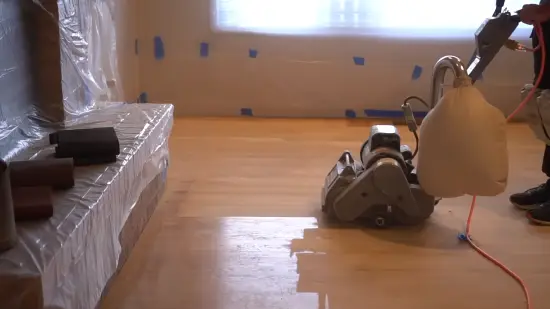
To properly prepare the floors for refinishing, you need to remove all furniture and thoroughly clean the surface. Start by clearing the room of any obstacles, such as chairs, tables, or rugs. This will allow you to have full access to the entire floor area.
Next, sweep the floors to remove any loose dirt or debris. Use a vacuum with a floor attachment to remove all dust completely.
For thorough cleaning, consider using a hardwood floor cleaner and a mop. This will help eliminate any built-up grime or residue.
Moreover, inspect the floor for any protruding nails or other objects that could cause damage during refinishing. Address these issues before proceeding to the next step.
Step 02: Sanding
Once the room is clear, you can begin the sanding process. Begin by using a coarse-grit sandpaper or sanding machine to remove the top layer of the wood. This will effectively remove any old finish, scratches, stains, or imperfections on the surface.
Make sure to sand in the direction of the wood grain to achieve a smooth and even result. After sanding with the coarse-grit sandpaper, switch to finer-grit sandpaper to further refine the surface. This will create a smooth and uniform surface, preparing it for staining and sealing.
Step 03: Staining
Once the sanding process is complete, you can enhance the color of the wood and achieve the desired appearance by applying a stain.
Stains are available in a variety of colors, allowing you to choose the shade that best compliments your decor. Be sure to stir the stain thoroughly before applying it to ensure an even color distribution.
Use a brush or rag to apply the stain, working in small sections and following the grain of the wood. Allow the stain to penetrate the wood for the recommended amount of time, usually around 10-15 minutes, before wiping off any excess with a clean cloth.
Step 04: Top Coating
After the stain has dried, you can apply a top coat to protect and enhance the appearance of the wood. To apply the top coat, use a brush or roller and work in small sections. Allow it to dry thoroughly before walking on the floor with socks or shoes.
The top coat serves as a barrier that seals the wood, preventing it from being easily damaged by minor incidents like scuffs and water stains. By applying a top coat, you can extend the lifespan of your hardwood floors and keep them looking polished and glossy.
This protective layer acts as a shield, safeguarding the wood from everyday wear and tear. Whether you have pets or children or simply want to maintain the beauty of your floors, a top coat is essential.
Is it cheaper to refinish hardwood floors or replace them?
It’s typically more cost-effective to refinish hardwood floors instead of replacing them. When considering the costs, it becomes clear that refinishing is the more budget-friendly option.
Replacing hardwood floors involves additional expenses such as purchasing new wood, installation costs, and labor charges for tearing up and disposing of the existing hardwood. These costs can quickly add up, making the replacement process quite expensive.
Alternatively, refinishing hardwood floors involves sanding down the existing surface, applying a new finish, and adding a protective top coat. This process is generally less expensive, eliminating the need for new materials and extensive labor.
Is it better to strip or sand hardwood floors?
Stripping hardwood floors involves using a chemical stripper to remove the existing finish, while sanding involves using a sander to remove the top layer of wood along with the finish. Both methods have advantages, but stripping is the way to go if you have intricate pieces with carved details.
It allows you to reach into crevices where sandpaper can’t, ensuring a thorough and even removal of the old finish. Plus, it’s less labor-intensive compared to sanding, saving you physical effort.
So, if you want to achieve a pristine finish on your hardwood floors, stripping is definitely the better option.
When should you not refinish hardwood floors?
When your hardwood floors have extensive damage such as warping, chipping, stains, or termite infestations, refinishing is not recommended.
This is because when the damage reaches this level, the floor’s structural integrity may be compromised, making it difficult to refinish and restore.
Revive Your Home with Stunning Refinished Hardwood Floors

Refinishing hardwood floors can be a cost-effective way to breathe new life into your space. By stripping and refinishing your floors according to our discussion, you can remove scratches, stains, and imperfections, leaving behind a beautiful and renewed surface.
While the cost can vary depending on factors such as the size of the space and the condition of the floors, it is generally cheaper to refinish hardwood floors than to replace them entirely.
So why not consider refinishing your hardwood floors? You may be surprised at how transformational the results can be.





